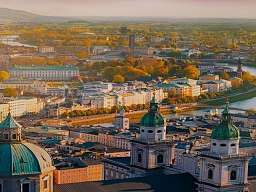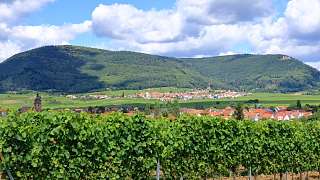Romantik Blog
The German Wine Route. Where wine flows, life flourishes.
The German Wine Route winds its way through the heart of the Palatinate region for around 85 kilometres, from the sleepy village of Schweigen-Rechtenbach on the French border to the Wine Gate in Bockenheim in the north. In between? A fireworks display of wine festivals, winegrowers' villas, romantic half-timbered houses and golden vines. Perfect for connoisseurs, hikers, cyclists and anyone who just wants to go with the flow. Find out more about the German Wine Route in our blog and discover accommodation nearby that is definitely worth a little detour.
The route
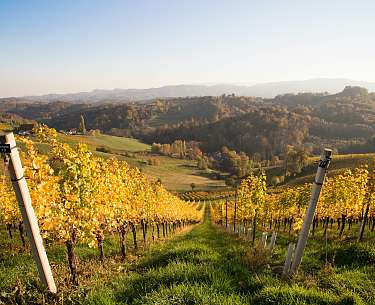
Wine romance & recklessness
Southern sun in a glass, castles on the horizon and picture-perfect villages. Anyone travelling along the German Wine Route is immersed in a lifestyle that oscillates somewhere between Mediterranean light-heartedness and Palatinate cosiness. It is not only the wine that captivates here, but also the entire landscape, the history, the people and the culinary delights to be found at every turn.
From south to north: the treasures of the German Wine Route.
The German Wine Route begins in the far south, at the German Wine Gate in Schweigen-Rechtenbach, and winds its way through a landscape of vineyards and villages. On the way north, the most beautiful wine villages are strung together like a chain: Bad Bergzabern, Klingenmünster, Edenkoben, romantic St. Martin, Maikammer and dreamy Rhodt unter Rietburg. Then comes the lively heart of the route: Bad Dürkheim. The route continues via Wachenheim, elegant Deidesheim, Neustadt an der Weinstraße with its Hambach Castle, to Freinsheim and finally to the northern gate of the Wine Route: Bockenheim an der Weinstraße. Each of these places is a little treasure with its own character, its own signature and, of course, its own wine.
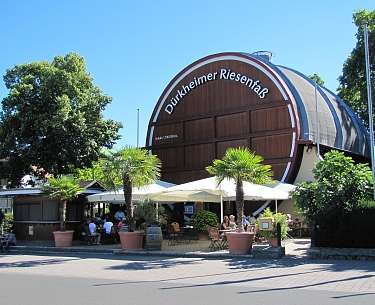
Bad Dürkheim. The heart of the German Wine Route.
By the time you reach Bad Dürkheim, you will know that this is the heart of the route. Nestled amid a sea of vines and surrounded by the dense greenery of the Palatinate Forest, the air is filled with the scent of wine, wood and ripe fruit. The town is a spa town, cultural centre and wine town all in one. The gigantic Dürkheim giant barrel is a symbol of the deep pride in wine, and right next to it, the graduation tower, an architectural work of art made of wood and salt air, attracts all those who want to breathe deeply – in the truest sense of the word.
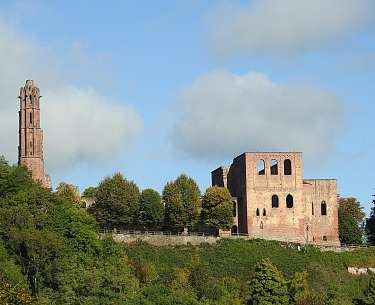
And then there is late summer, when the Wurstmarkt transforms the city into a frenzy of music, festivities and wine. It is the largest wine festival in the world, but instead of crowds, you can expect a feast for all the senses: authentic, warm and intoxicatingly beautiful. Those who want to delve deeper can hike up to the ruins of Hardenburg Castle or be enchanted by the mystical flair of Limburg Monastery. From above, the panoramic view stretches far across the world of vines.
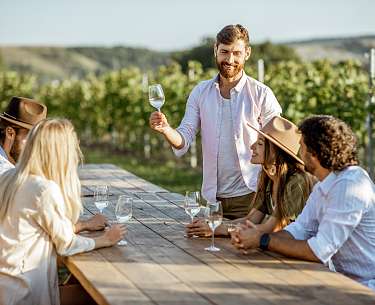
Golden Seasons.
Spring brings a sea of blossoms from almond trees, summer offers fragrant gardens and balmy evenings in the winery courtyard. But autumn is a riot of colours, grape harvests and festivals where you toast with strangers who quickly become friends. Because when the scent of onion tart wafts through the streets, the most beautiful time of the year begins on the German Wine Route: the wine festival season.
The most beautiful wine festivals on the German Wine Route.
Dürkheim Sausage Market – The largest wine festival in the world.
Let's start with a real giant: the Dürkheim Sausage Market is no ordinary wine festival – it is the largest in the world. Every year in September, Bad Dürkheim is transformed into a sea of lights, music, Dubbegläsers (traditional wine glasses) and joie de vivre. In traditional cart stands, people drink, laugh, dance – and, of course, drink Palatinate wine, which only this region can produce. Anyone who has ever been there knows: this is where the heart of the Palatinate beats.
German Wine Harvest Festival in Neustadt – the crowning glory of autumn.
A few kilometres further south, Neustadt an der Weinstraße invites visitors to the German Wine Harvest Festival from the end of September to mid-October – the highlight of the wine festival season. In the quaint Haiselscher, a village of lovingly decorated half-timbered huts, the new wine flows freely. The highlight is Germany's largest wine festival parade, a colourful spectacle with music, traditional costumes and lovingly decorated floats. Anyone who wants to know how deeply wine and culture are rooted in the Palatinate can experience it here first-hand.
Rhodt unter Rietburg – wine on Theresienstraße.
The ‘New Wine Festival’ in Rhodt unter Rietburg is a real insider tip. On the third weekend in September, the wineries open their doors, live music fills the winding courtyards, and the scent of fresh Federweißer wine fills the air. Surrounded by chestnut trees, sandstone façades and a sea of autumn vines, you can enjoy wine with all your senses in a quiet, family atmosphere.
Small festivals with big character.
Away from the big stages, there are also enchanting autumn festivals along the German Wine Route that exude a genuine Palatinate lifestyle. In Böchingen, for example, winegrowers celebrate their ‘Böchinger Herbst’ (Böchingen Autumn) over several weekends with new wine, sweet pastries and plenty of magic. Freinsheim invites you to a culinary wine hike, where you can taste fine wines among vineyards and half-timbered houses. In Landau, the Federweißenfest (young wine festival) at the beginning of October welcomes the new wine with a farmers' market and regional specialities. And in tranquil Birkweiler, the ‘Wine Autumn’ at the end of October marks the grand finale of the harvest season. A festival of bright colours and warm hearts.
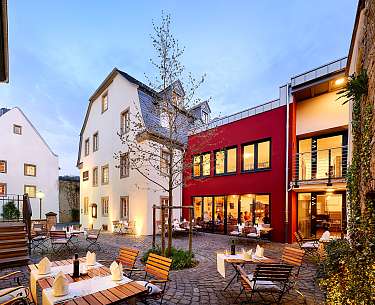
Insider tip: Take a detour to Meisenheim.
Medieval flair, top-quality wine and Michelin-starred cuisine: just a short detour west of the German Wine Route lies a place that seems to have fallen out of time – Meisenheim. An enchanted little town on the Glan River that has preserved its medieval old town. Cobbled streets, half-timbered houses, Gothic churches and hidden courtyards – this is a worthwhile detour for anyone who wants to combine enjoyment with relaxation.
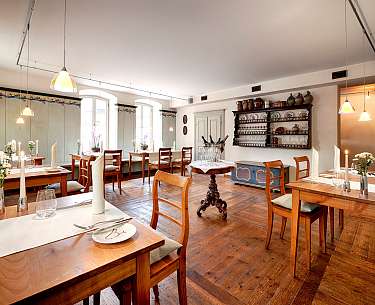
The best place for a stylish stay is the Romantik® Hotel Meisenheimer Hof, a historic city hotel with its own Disibodenberg vineyard, an excellent restaurant and a passion for culinary delights down to the smallest detail. Whether in the Michelin-starred restaurant, at a wine tasting or during a cooking class in the hotel's own cooking school: here you can enjoy the Nahe region at the highest level.
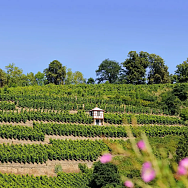


Hotels nahe der Deutschen Weinstraße
Germany
FAQ Frequently asked questions & answers
The German Wine Route is an approximately 85-kilometre-long holiday route in the Palatinate region that runs through Germany's largest wine-growing area – from Schweigen-Rechtenbach on the French border to Bockenheim in the north.
The most famous places include Deidesheim, Neustadt an der Weinstraße, Bad Dürkheim, Edenkoben, Maikammer and Wachenheim. In total, the route passes through more than 20 picturesque wine villages.
The Wine Route is beautiful all year round. However, spring is particularly popular during the almond blossom season (March/April) and autumn during the grape harvest and numerous wine festivals (September/October).
The best way to experience the Wine Route is by car, bicycle or on hiking tours. Many places also offer covered wagon rides through the vineyards or regional tourist trains.
Yes. Almost every town celebrates its own wine festival, including the famous Wurstmarkt in Bad Dürkheim, the largest wine festival in the world. Smaller, family-friendly farm festivals are also a special experience.
The Palatinate is famous for its Riesling, but Pinot Blanc, Pinot Gris, Dornfelder and Pinot Noir are also very popular. More and more winegrowers are also producing excellent sparkling wines.
Absolutely! Many places offer child-friendly experiences, adventure farms, castles such as Trifels, or playgrounds along hiking trails. Adventure trails through the vineyards are also particularly exciting for children.
From boutique hotels on vineyards to cosy guesthouses and wellness hotels, there is something for everyone. Many accommodations are owner-managed and designed with great attention to detail.
Definitely. Typical dishes include Palatinate Saumagen, tarte flambée, ‘Weck, Worscht un Woi’ (bread rolls, sausage and wine) and seasonal delicacies such as onion tart in autumn or asparagus in spring.
For a relaxed trip filled with enjoyment and exploration, you should plan at least 3 to 5 days. However, week-long tours with stops in various wine villages are also ideal.
Yes, the German Wine Route cycle path runs parallel to the route. There are also numerous hiking trails, such as the Pfälzer Weinsteig, which lead through vineyards, forests and villages.
The German Wine Gate in Schweigen-Rechtenbach marks the southern entrance to the Wine Route. It is a symbolic, historic building and a popular photo spot.
Yes, many wineries invite visitors to wine tastings, cellar tours or leisurely shopping. Registration is recommended, especially in the off-season.
Places worth visiting include Hambach Castle (the cradle of German democracy), the ruins of Wachtenburg Castle, Villa Ludwigshöhe Castle and the Wine Museum in Mußbach.
Post your comment
Comments
No one has commented on this page yet.
RSS feed for comments on this page RSS feed for all comments
More interesting articles
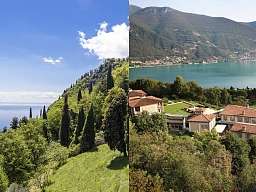
Upper Italian Lakes - Time Travel into the Originality of Northern Italy
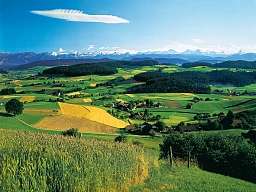
Romantik Country Hotels in Switzerland
